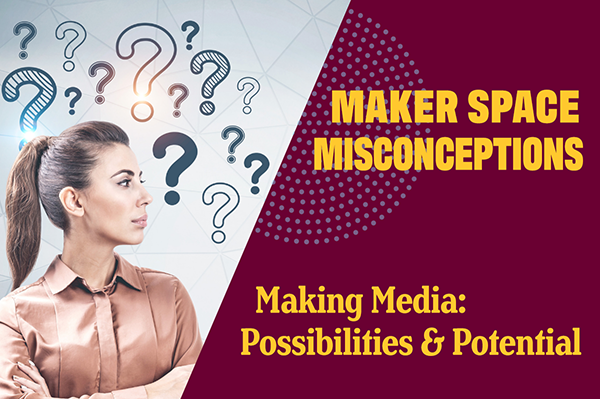From the Office of Curriculum and Instruction Support (CIS), this series will shine new light on our Media Maker Spaces. The next four editions of this newsletter will debunk Maker Space misconceptions, demystify the experience of using our Maker Spaces, and provide suggestions to maximize the impact of your teaching and learning through course media.
Misconception(s): My materials won’t work as recorded media. What I do doesn’t translate. Videos are only for “lectures.”
If these thoughts come to mind when you hear about our Maker Spaces – keep reading! Let us debunk these and more of your misconceptions!
Why media?
“Instruction” looks and feels quite different now. More than ever, we are positioned to flexibly accommodate these differences by applying digital media to the learning experiences we create for our students. Benefits of incorporating well-developed media into your courses are widespread and include:
- Accessibility: Professionally controlled features like sound, lighting, and captioning, ensure that all learners have access to an equitable learning experience, regardless of where they are (O’Keefe et al., 2020).
- Efficiency: Maximize student time outside-of-class, reallocate responsibility for engaging with materials onto the students, eliminate the need for repeated information, and more.
- Scholarship: Motivate learners to interact with materials, make real-life connections to content, and increase the depth of learning (Mintz, 2020; Linden, 2012; Greenberg & Zanetis, 2012).
- Instructor presence: Video is a great way to build instructor immediacy and presence, which is a statistically significant predictor of student affective learning, cognition, and motivation. (Baker, 2010; Ladyshewsky, 2013).
I can make… anything?!
Considering our spaces’ capabilities, anything can be created or transformed into a powerful piece of recorded media. Of course, a standard presentation fits the media product model, but don’t let your imagination stop there! These are just some examples of what faculty have produced in our Maker Spaces:
- Course Overview, FAQs, assignment instructions, and feedback
- Step by step walkthrough of examples
- Laboratory experiments, equipment set up and use, and data analyses
- Physical movement techniques, trainings, and demonstrations
- Interviews of guest speakers
- Promotional materials, logistical communications, and conference presentation
Don’t take our word for it…
Our Maker Space users say:
- “[Moving this content, through video] to outside class lets the students view it as many times as they like and frees up class time for actual discussions where the students are driving the lesson.”
- “Using video has increased community; students feel like they know me better when they hear me…”
- “Students have responded favorably to having the video guidance…They’re more confident about how to approach assignments and informed about their work and the course in general. “
- It was nice to have [a] professional-looking setting for my video since it was being used for a national conference. Being able to draw on the slides…during the presentation was really nice.
- “…the videos are high quality and it’s great to be able to annotate slides.”
- “This is just too cool. You come in, record, and walk out with a finished product.”
Where do I start?
- Read about our Video Maker Space, Audio Maker Space, and Lightboard Maker Space, and schedule an appointment online.
- Learn about creating multimedia, see some examples, and review even more of our media production resources: Best Practices for Recording Content for your Courses, 5 Things You Must Do BEFORE Recording, What can I create?
- Email us with questions or to make an appointment to visit the spaces.
Stay tuned for our next issue, focusing on how easy our spaces are to use. Get familiar with the studio(s) before you come in.
Reference(s):
- Baker, C. (2010). The Impact of Instructor Immediacy and Presence for Online Student Affective Learning, Cognition, and Motivation. Journal of Educators Online, 7(1).
- Greenberg, A.D., & Zanetis, J. (2012) The impact of broadcast and streaming video in education. Cisco Systems. Retrieved from https://www.cisco.com/c/dam/en_us/solutions/industries/docs/education/ciscovideowp.pdf
- Ladyshewsky, R. (2013). Instructor Presence in Online Courses and Student Satisfaction. International Journal for the Scholarship of Teaching and Learning. 7(1), 1-23.
- Linden, S. (2012) Using videos in the virtual classroom. Faculty eCommons Retrieved from https://facultyecommons.com/effective-use-of-video-in-online-courses/
- Mintz, S. (2020). Who are our students? Inside Higher Ed. Retrieved from https://www.insidehighered.com/blogs/higher-ed-gamma/who-are-our-students-0
O’Keefe, L., Rafferty, J., Gunder, A., & Vignare, K. (2020, May 18). Delivering high-quality instruction online in response to COVID-19: Faculty playbook. Every Lear


1 thought on “Making Maker Space Media …”
Comments are closed.